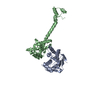+ Open data
Open data
- Basic information
Basic information
| Entry | Database: EMDB / ID: EMD-3340 | |||||||||
|---|---|---|---|---|---|---|---|---|---|---|
| Title | Atomic cryoEM structure of Hsp90/Cdc37/Cdk4 complex | |||||||||
 Map data Map data | Reconstruction of Hsp90:Cdc37:Cdk4 complex. Part of series of maps, the highest resolution map being EMD-3337. This is a different subclass from the same particles as in EMD-3337, having well defined Cdc37MC density. | |||||||||
 Sample Sample |
| |||||||||
 Keywords Keywords | Hsp90 / Cdc37 / Cdk4 / chaperone / kinase / unfolding | |||||||||
| Function / homology |  Function and homology information Function and homology informationcyclin D3-CDK4 complex / cyclin D1-CDK4 complex / cyclin D2-CDK4 complex / Evasion of Oncogene Induced Senescence Due to Defective p16INK4A binding to CDK4 / Evasion of Oxidative Stress Induced Senescence Due to Defective p16INK4A binding to CDK4 / cellular response to ionomycin / citrulline metabolic process / regulation of transcription initiation by RNA polymerase II / regulation of type II interferon-mediated signaling pathway / Evasion of Oncogene Induced Senescence Due to Defective p16INK4A binding to CDK4 and CDK6 ...cyclin D3-CDK4 complex / cyclin D1-CDK4 complex / cyclin D2-CDK4 complex / Evasion of Oncogene Induced Senescence Due to Defective p16INK4A binding to CDK4 / Evasion of Oxidative Stress Induced Senescence Due to Defective p16INK4A binding to CDK4 / cellular response to ionomycin / citrulline metabolic process / regulation of transcription initiation by RNA polymerase II / regulation of type II interferon-mediated signaling pathway / Evasion of Oncogene Induced Senescence Due to Defective p16INK4A binding to CDK4 and CDK6 / Evasion of Oxidative Stress Induced Senescence Due to Defective p16INK4A binding to CDK4 and CDK6 / Drug-mediated inhibition of CDK4/CDK6 activity / regulation of type B pancreatic cell proliferation / HSP90-CDC37 chaperone complex / very long-chain fatty acid metabolic process / negative regulation of proteasomal protein catabolic process / Aryl hydrocarbon receptor signalling / aryl hydrocarbon receptor complex / dynein axonemal particle / histone methyltransferase binding / Transcriptional regulation by RUNX2 / cellular response to phorbol 13-acetate 12-myristate / mitochondrial genome maintenance / receptor ligand inhibitor activity / positive regulation of type 2 mitophagy / ATP-dependent protein binding / positive regulation of protein localization to cell surface / protein kinase regulator activity / protein folding chaperone complex / cyclin-dependent protein serine/threonine kinase regulator activity / post-transcriptional regulation of gene expression / regulation of cyclin-dependent protein serine/threonine kinase activity / Respiratory syncytial virus genome replication / positive regulation of transforming growth factor beta receptor signaling pathway / telomerase holoenzyme complex assembly / Uptake and function of diphtheria toxin / PTK6 Regulates Cell Cycle / Drug-mediated inhibition of ERBB2 signaling / Resistance of ERBB2 KD mutants to trastuzumab / Resistance of ERBB2 KD mutants to sapitinib / Resistance of ERBB2 KD mutants to tesevatinib / Resistance of ERBB2 KD mutants to neratinib / Resistance of ERBB2 KD mutants to osimertinib / Resistance of ERBB2 KD mutants to afatinib / Resistance of ERBB2 KD mutants to AEE788 / Resistance of ERBB2 KD mutants to lapatinib / Drug resistance in ERBB2 TMD/JMD mutants / regulation of type I interferon-mediated signaling pathway / TPR domain binding / Defective binding of RB1 mutants to E2F1,(E2F2, E2F3) / Assembly and release of respiratory syncytial virus (RSV) virions / dendritic growth cone / The NLRP3 inflammasome / protein phosphatase activator activity / Sema3A PAK dependent Axon repulsion / regulation of protein ubiquitination / HSF1-dependent transactivation / bicellular tight junction / response to unfolded protein / cyclin-dependent kinase / HSF1 activation / telomere maintenance via telomerase / cyclin-dependent protein serine/threonine kinase activity / protein targeting / chaperone-mediated protein complex assembly / Attenuation phase / Purinergic signaling in leishmaniasis infection / RHOBTB2 GTPase cycle / axonal growth cone / cyclin-dependent protein kinase holoenzyme complex / DNA polymerase binding / supramolecular fiber organization / : / regulation of G2/M transition of mitotic cell cycle / positive regulation of G2/M transition of mitotic cell cycle / heat shock protein binding / Signaling by ERBB2 / negative regulation of proteasomal ubiquitin-dependent protein catabolic process / protein folding chaperone / nitric-oxide synthase regulator activity / cellular response to interleukin-4 / peptide binding / cyclin binding / HSP90 chaperone cycle for steroid hormone receptors (SHR) in the presence of ligand / Constitutive Signaling by Overexpressed ERBB2 / ESR-mediated signaling / Ubiquitin-dependent degradation of Cyclin D / positive regulation of cell differentiation / placenta development / Hsp90 protein binding / ATP-dependent protein folding chaperone / Signaling by ERBB2 TMD/JMD mutants / Constitutive Signaling by EGFRvIII / Signaling by ERBB2 ECD mutants / tau protein binding / Signaling by ERBB2 KD Mutants / DDX58/IFIH1-mediated induction of interferon-alpha/beta / Oncogene Induced Senescence / Regulation of actin dynamics for phagocytic cup formation / Transcriptional regulation of white adipocyte differentiation Similarity search - Function | |||||||||
| Biological species |  Homo sapiens (human) Homo sapiens (human) | |||||||||
| Method | single particle reconstruction / cryo EM / Resolution: 7.2 Å | |||||||||
 Authors Authors | Verba KA / Wang RYR / Arakawa A / Liu Y / Shirouzu M / Yokoyama S / Agard DA | |||||||||
 Citation Citation |  Journal: Science / Year: 2016 Journal: Science / Year: 2016Title: Atomic structure of Hsp90-Cdc37-Cdk4 reveals that Hsp90 traps and stabilizes an unfolded kinase. Authors: Kliment A Verba / Ray Yu-Ruei Wang / Akihiko Arakawa / Yanxin Liu / Mikako Shirouzu / Shigeyuki Yokoyama / David A Agard /   Abstract: The Hsp90 molecular chaperone and its Cdc37 cochaperone help stabilize and activate more than half of the human kinome. However, both the mechanism by which these chaperones assist their "client" ...The Hsp90 molecular chaperone and its Cdc37 cochaperone help stabilize and activate more than half of the human kinome. However, both the mechanism by which these chaperones assist their "client" kinases and the reason why some kinases are addicted to Hsp90 while closely related family members are independent are unknown. Our structural understanding of these interactions is lacking, as no full-length structures of human Hsp90, Cdc37, or either of these proteins with a kinase have been elucidated. Here we report a 3.9 angstrom cryo-electron microscopy structure of the Hsp90-Cdc37-Cdk4 kinase complex. Surprisingly, the two lobes of Cdk4 are completely separated with the β4-β5 sheet unfolded. Cdc37 mimics part of the kinase N lobe, stabilizing an open kinase conformation by wedging itself between the two lobes. Finally, Hsp90 clamps around the unfolded kinase β5 strand and interacts with exposed N- and C-lobe interfaces, protecting the kinase in a trapped unfolded state. On the basis of this structure and an extensive amount of previously collected data, we propose unifying conceptual and mechanistic models of chaperone-kinase interactions. | |||||||||
| History |
|
- Structure visualization
Structure visualization
| Movie |
 Movie viewer Movie viewer |
|---|---|
| Structure viewer | EM map:  SurfView SurfView Molmil Molmil Jmol/JSmol Jmol/JSmol |
| Supplemental images |
- Downloads & links
Downloads & links
-EMDB archive
| Map data |  emd_3340.map.gz emd_3340.map.gz | 49.7 MB |  EMDB map data format EMDB map data format | |
|---|---|---|---|---|
| Header (meta data) |  emd-3340-v30.xml emd-3340-v30.xml emd-3340.xml emd-3340.xml | 17.4 KB 17.4 KB | Display Display |  EMDB header EMDB header |
| FSC (resolution estimation) |  emd_3340_fsc.xml emd_3340_fsc.xml | 10.7 KB | Display |  FSC data file FSC data file |
| Images |  emd_3340.tif emd_3340.tif | 171.2 KB | ||
| Archive directory |  http://ftp.pdbj.org/pub/emdb/structures/EMD-3340 http://ftp.pdbj.org/pub/emdb/structures/EMD-3340 ftp://ftp.pdbj.org/pub/emdb/structures/EMD-3340 ftp://ftp.pdbj.org/pub/emdb/structures/EMD-3340 | HTTPS FTP |
-Validation report
| Summary document |  emd_3340_validation.pdf.gz emd_3340_validation.pdf.gz | 251.9 KB | Display |  EMDB validaton report EMDB validaton report |
|---|---|---|---|---|
| Full document |  emd_3340_full_validation.pdf.gz emd_3340_full_validation.pdf.gz | 251 KB | Display | |
| Data in XML |  emd_3340_validation.xml.gz emd_3340_validation.xml.gz | 10.7 KB | Display | |
| Arichive directory |  https://ftp.pdbj.org/pub/emdb/validation_reports/EMD-3340 https://ftp.pdbj.org/pub/emdb/validation_reports/EMD-3340 ftp://ftp.pdbj.org/pub/emdb/validation_reports/EMD-3340 ftp://ftp.pdbj.org/pub/emdb/validation_reports/EMD-3340 | HTTPS FTP |
-Related structure data
| Related structure data |  5fwpMC  3337C  3338C  3339C  3341C  3342C  3343C  3344C  5fwkC  5fwlC  5fwmC M: atomic model generated by this map C: citing same article ( |
|---|---|
| Similar structure data |
- Links
Links
| EMDB pages |  EMDB (EBI/PDBe) / EMDB (EBI/PDBe) /  EMDataResource EMDataResource |
|---|---|
| Related items in Molecule of the Month |
- Map
Map
| File |  Download / File: emd_3340.map.gz / Format: CCP4 / Size: 62.5 MB / Type: IMAGE STORED AS FLOATING POINT NUMBER (4 BYTES) Download / File: emd_3340.map.gz / Format: CCP4 / Size: 62.5 MB / Type: IMAGE STORED AS FLOATING POINT NUMBER (4 BYTES) | ||||||||||||||||||||||||||||||||||||||||||||||||||||||||||||
|---|---|---|---|---|---|---|---|---|---|---|---|---|---|---|---|---|---|---|---|---|---|---|---|---|---|---|---|---|---|---|---|---|---|---|---|---|---|---|---|---|---|---|---|---|---|---|---|---|---|---|---|---|---|---|---|---|---|---|---|---|---|
| Annotation | Reconstruction of Hsp90:Cdc37:Cdk4 complex. Part of series of maps, the highest resolution map being EMD-3337. This is a different subclass from the same particles as in EMD-3337, having well defined Cdc37MC density. | ||||||||||||||||||||||||||||||||||||||||||||||||||||||||||||
| Projections & slices | Image control
Images are generated by Spider. | ||||||||||||||||||||||||||||||||||||||||||||||||||||||||||||
| Voxel size | X=Y=Z: 1.315 Å | ||||||||||||||||||||||||||||||||||||||||||||||||||||||||||||
| Density |
| ||||||||||||||||||||||||||||||||||||||||||||||||||||||||||||
| Symmetry | Space group: 1 | ||||||||||||||||||||||||||||||||||||||||||||||||||||||||||||
| Details | EMDB XML:
CCP4 map header:
| ||||||||||||||||||||||||||||||||||||||||||||||||||||||||||||
-Supplemental data
- Sample components
Sample components
-Entire : Complex of Human Hsp90 beta, human Cdc37 and human Cdk4
| Entire | Name: Complex of Human Hsp90 beta, human Cdc37 and human Cdk4 |
|---|---|
| Components |
|
-Supramolecule #1000: Complex of Human Hsp90 beta, human Cdc37 and human Cdk4
| Supramolecule | Name: Complex of Human Hsp90 beta, human Cdc37 and human Cdk4 type: sample / ID: 1000 / Details: All three proteins were co-expressed in Sf9 cells. Oligomeric state: One Hsp90 homodimer binds to one Cdc37 and one Cdk4 Number unique components: 3 |
|---|---|
| Molecular weight | Experimental: 245 KDa / Theoretical: 245 KDa / Method: As cloned, verified by SDS-PAGE |
-Macromolecule #1: Heat Shock Protein HSP 90 beta
| Macromolecule | Name: Heat Shock Protein HSP 90 beta / type: protein_or_peptide / ID: 1 / Name.synonym: Hsp90 / Number of copies: 2 / Oligomeric state: Dimer / Recombinant expression: Yes |
|---|---|
| Source (natural) | Organism:  Homo sapiens (human) / synonym: Human / Location in cell: cytoplasm Homo sapiens (human) / synonym: Human / Location in cell: cytoplasm |
| Molecular weight | Theoretical: 83 KDa |
| Recombinant expression | Organism:  |
| Sequence | UniProtKB: Heat shock protein HSP 90-beta / GO: citrulline metabolic process / InterPro: Heat shock protein Hsp90 family |
-Macromolecule #2: Hsp90 co-chaperone Cdc37
| Macromolecule | Name: Hsp90 co-chaperone Cdc37 / type: protein_or_peptide / ID: 2 / Name.synonym: Cdc37 / Number of copies: 1 / Recombinant expression: Yes |
|---|---|
| Source (natural) | Organism:  Homo sapiens (human) / synonym: Human / Location in cell: throughout Homo sapiens (human) / synonym: Human / Location in cell: throughout |
| Molecular weight | Theoretical: 44.5 KDa |
| Recombinant expression | Organism:  |
| Sequence | UniProtKB: Hsp90 co-chaperone Cdc37 / GO: mitochondrial genome maintenance |
-Macromolecule #3: Cyclin-dependent kinase 4
| Macromolecule | Name: Cyclin-dependent kinase 4 / type: protein_or_peptide / ID: 3 / Name.synonym: Cdk4 / Number of copies: 1 / Recombinant expression: Yes |
|---|---|
| Source (natural) | Organism:  Homo sapiens (human) / synonym: Human / Location in cell: throughout Homo sapiens (human) / synonym: Human / Location in cell: throughout |
| Molecular weight | Theoretical: 33.7 KDa |
| Recombinant expression | Organism:  |
| Sequence | UniProtKB: Cyclin-dependent kinase 4 / GO: very long-chain fatty acid metabolic process / InterPro: Protein kinase domain |
-Experimental details
-Structure determination
| Method | cryo EM |
|---|---|
 Processing Processing | single particle reconstruction |
| Aggregation state | particle |
- Sample preparation
Sample preparation
| Concentration | 0.27 mg/mL |
|---|---|
| Buffer | pH: 7.5 Details: 20mM Tris-HCl (pH 7.5), 150 mM NaCl, 10 mM KCl, 10 mM MgCl2, 20 mM Na2MoO4, 2mM DTT, 0.085mM DDM |
| Grid | Details: Glow discharged for 30 sec, C-flat 400 mesh 1.2/1.3 thick carbon grids (Protochips) |
| Vitrification | Cryogen name: ETHANE / Chamber humidity: 90 % / Chamber temperature: 95 K / Instrument: FEI VITROBOT MARK III / Method: Single blot from 4 to 6 seconds, at 20C |
- Electron microscopy
Electron microscopy
| Microscope | FEI TITAN KRIOS |
|---|---|
| Alignment procedure | Legacy - Astigmatism: At high mag via FT. |
| Date | Nov 25, 2014 |
| Image recording | Category: CCD / Film or detector model: GATAN K2 SUMMIT (4k x 4k) / Number real images: 3718 / Average electron dose: 44 e/Å2 / Details: 38 frames, 7.6 seconds total exposure / Bits/pixel: 8 |
| Electron beam | Acceleration voltage: 300 kV / Electron source:  FIELD EMISSION GUN FIELD EMISSION GUN |
| Electron optics | Illumination mode: OTHER / Imaging mode: BRIGHT FIELD / Cs: 2.7 mm / Nominal defocus max: 3.8 µm / Nominal defocus min: 1.4 µm / Nominal magnification: 22500 |
| Sample stage | Specimen holder model: FEI TITAN KRIOS AUTOGRID HOLDER |
| Experimental equipment |  Model: Titan Krios / Image courtesy: FEI Company |
- Image processing
Image processing
-Atomic model buiding 1
| Initial model | PDB ID: Chain - #0 - Chain ID: A / Chain - #1 - Chain ID: B / Chain - #2 - Chain ID: E / Chain - #3 - Chain ID: K |
|---|---|
| Software | Name: Chimera, Rosetta |
| Details | Cdc37 crystal structure from PDB:1US7 was fit into EMD-3340 manually and then with UCSF Chimera "Fit In Map" tool. The model was truncated at residue 260, as there was no reliable density for the rest of the crystal structure. PDB:5FWK and the above fit crystal structure for residues 148-260 were loaded in Coot. The residues 133-147 were built in by hand into the Cdc37 Reconstruction and residues 245-260 (helix) were rotated as a rigid body. To relieve atomic clashes or bond length/angle distortions at the linker regions, the resulting model was subjected to "Cartesian space relax" protocol within EMD-3340 map using Rosetta. Final model was selected using the combined score of Rosetta all-atom physically-realistic score and electron density score. |
| Refinement | Space: REAL / Protocol: FLEXIBLE FIT / Overall B value: 141 Target criteria: cross correlation of fit into the density with Rosetta force field score. |
| Output model |  PDB-5fwp: |
-Atomic model buiding 2
| Initial model | PDB ID: Chain - #0 - Chain ID: A / Chain - #1 - Chain ID: B / Chain - #2 - Chain ID: E / Chain - #3 - Chain ID: K |
|---|---|
| Software | Name: Chimera, Rosetta |
| Refinement | Space: REAL / Protocol: FLEXIBLE FIT / Overall B value: 141 Target criteria: cross correlation of fit into the density with Rosetta force field score. |
| Output model |  PDB-5fwp: |
 Movie
Movie Controller
Controller



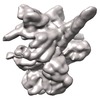
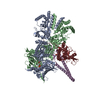
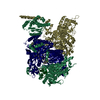


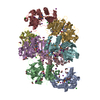
























 Z (Sec.)
Z (Sec.) Y (Row.)
Y (Row.) X (Col.)
X (Col.)






















